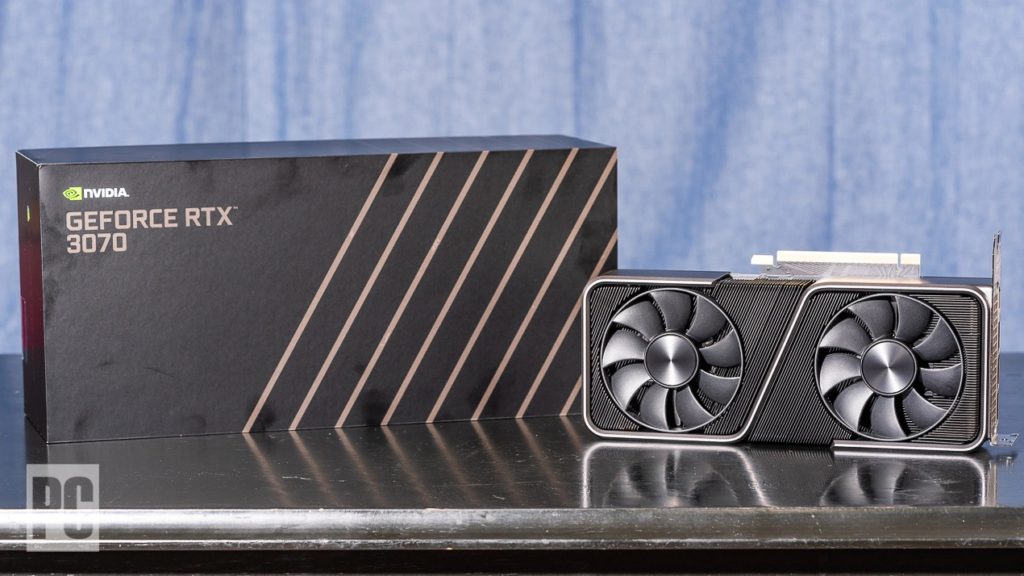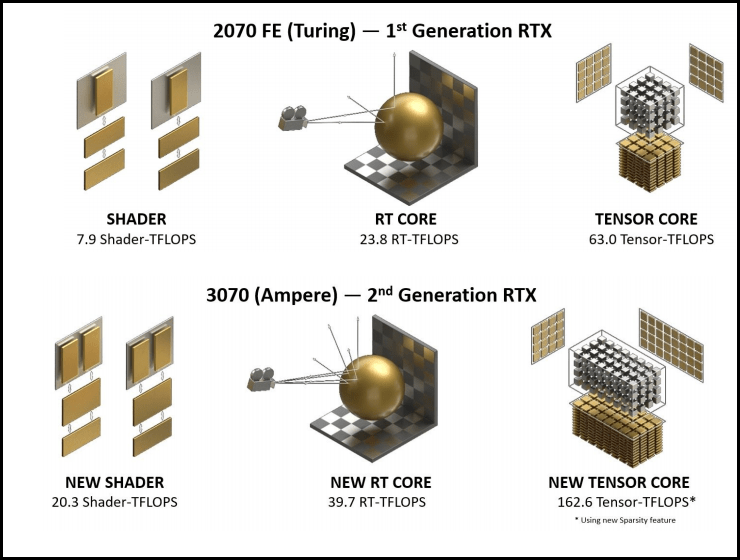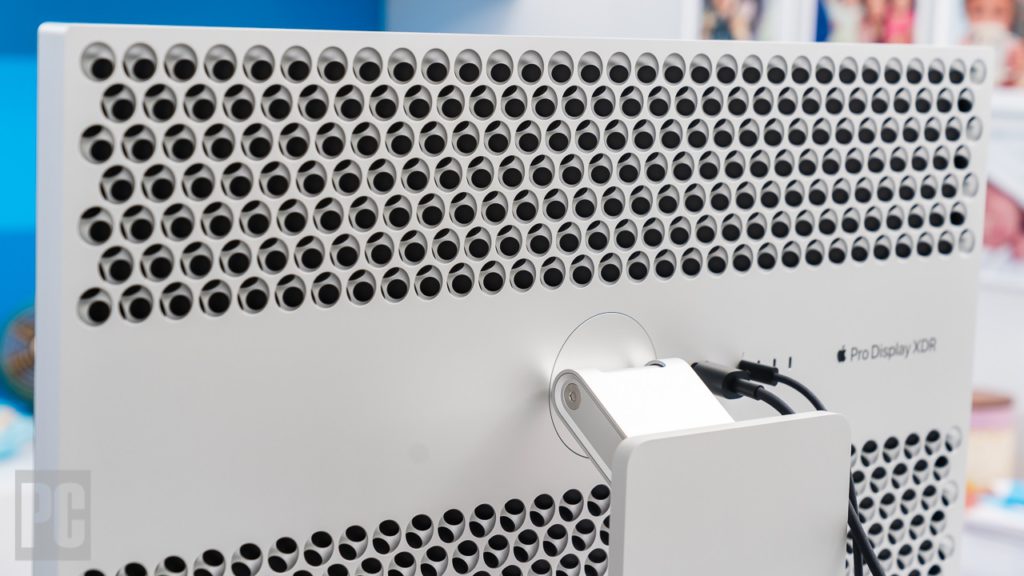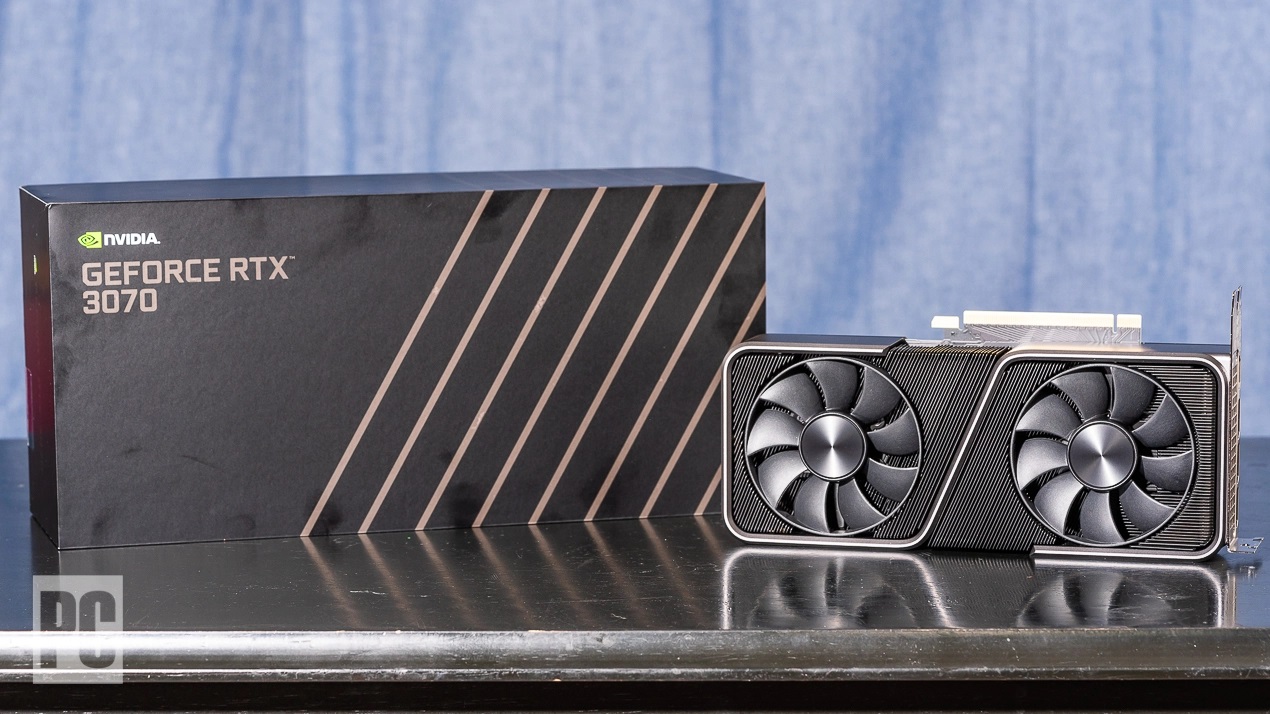
“Faster than RTX 2080 Ti.” You might have seen Nvidia’s claim a few weeks back; we saw it, too. That was a tall order for Nvidia’s $499 “Ampere”-based GeForce RTX 3070 Founders Edition graphics card. The mission: Beat last generation’s top-end “Turing” card (the $1,199 Nvidia GeForce RTX 2080 Ti Founders Edition), and do it for less than half the price. Well, the numbers are in, and we have to give Nvidia some serious props. In our tests, at 4K resolution, the RTX 3070 indeed pulls off the frame-rate wins at times, and when it can’t, it is very close. Meanwhile, it trades blows with and sometimes ties the RTX 2080 Ti at lesser resolutions. Again: for $499.
It’s not a by-the-numbers TKO, but in a larger sense, what the RTX 3070 does is still a knockout. Pull back, and consider that the RTX 3070 is cheaper than the RTX 2080 Ti by a factor of, oh, an entire budget gaming PC. Plus, it flattens RTX 2070 cards (and all AMD comers) in our suite of benchmarks. The expertly designed GeForce RTX 3070 Founders Edition is not the absolute fastest video card on the planet, but it deals almost every other card on shelves today (barring its RTX 3080 and RTX 3090 kin) a brutal takedown. It earns our Editors’ Choice award and a perfect 5-star score as the best video-card value of this, or any, year.
The RTX 3070: Sussing Out the Specs
Before we get to that benchmark beatdown, though, let’s dig into the specifications of the Nvidia GeForce RTX 3070 Founders Edition. We’ll also see how it holds up against competing AMD options at a similar price, and against the cards, it’s set to replace in Nvidia’s Turing line, the GeForce RTX 2070 and RTX 2070 Super.
The RTX 3070 Founders Edition, like the RTX 3080 version, serves as a reference card for video-card makers, and a baseline on specs for the third-party versions of the RTX 3070 to come. Both it and the first third-party cards go on sale on Oct. 29. In the U.S., you’ll be able to buy RTX 3070 Founders Edition cards directly from Best Buy and Microcenter (online or in-store), while Canadian customers should pursue it at BestBuy.com.
A side note: Before we get into the nitty-gritty of the specs, it should be noted that last year I gave an Editors’ Choice award to the GeForce RTX 2070 Super as not just a great graphics card, but as one of the best values that Nvidia had offered to gamers in literal generations. It felt like a return to form, and up until the release of the RTX 3070, the RTX 2070 Super was the leader in gaming price-to-performance (with its driver stability taken into account as plus, too). This left the RTX 3070 with big shoes to fill both on value and raw performance, perhaps even larger than those of the RTX 3080 Founders Edition as the flagship of this new launch.
On to what I consider the most important spec for this particular card launch: the price. The RTX 2070 Founders Edition launched at $599, and Nvidia is dropping that by $100. Score one there, even before you install the card.
At the moment, the only competition AMD has at this price point are certain OEM models of the Radeon RX 5700 XT, or (if you can find one) a discounted AMD Radeon VII. It’s not a big secret that this could change soon, but for now, that’s what we’ve got solid numbers to compare to. In certain specs and nearly in launch price (though not in current street price), the reference-design AMD Radeon 5700 XT matches the RTX 3070, but the RTX 3070 comes to the table with so much upgraded gear and ancillary tech—DLSS support, a hyper-premium cooling design, and a major PCB shrink, for starters—that they might as well be different species altogether. Again, this could all change in the coming weeks, but until then, the Radeon RX 5700 XT is the key player from AMD’s camp.
This additional aspect of the pricing could affect a lot of kids’ stockings this holiday season: The $499 RTX 3070 Founders Edition is the same price as both the Xbox Series X and the non-digital edition of the Sony PlayStation 5. Now, of course, you’ll need a gaming PC for the graphics card to reside in after you’ve unwrapped it, which is a cost unto itself. But for anyone already with a reasonable PC to upgrade, and the luxury of a $500 choice between a new GPU or a console, this is the exact card you should set your sights on.
For those already living the #PCRideorDie life, it could be argued (and has been, extensively, on this site and others) that the cards set to benefit most from technologies like Nvidia’s DLSS aren’t necessarily the top-of-the-line ones, but rather the midrange and budget options like the RTX 3070 and (a rumored) possible RTX 3060 Ti. DLSS is a PC-only feature, and while it’s not the gangbusters system-seller we expected it to be just yet, the promise it holds for the gamers of tomorrow could be huge.
The DLSS efficiency hinges on the Tensor Cores in the new Ampere cards as much as on the muscle of the rest of the card. Though the number of Tensor Cores in the RTX 3070 is smaller than in the RTX 2070 Founders Edition, it’s the generational leap in architecture that supposedly separates their capabilities. The new Ampere-based third-generation Tensor Cores, in very short English, are considerably better than their predecessors, according to Nvidia. The new cores’ architecture improvements largely rethink the original approach found in Turing-based GPUs.
This means that while performance gains should be seen, regardless, due to the increased transistor density of the Samsung 8nm process in Ampere over Turing’s 14nm, Nvidia claims that the return in DLSS results should go well beyond that. Nvidia says to expect 2.7 times the performance with DLSS turned on over previous-generation Tensor Core iterations, but we’ll have to dig into the benchmarks to find out whether or not this claim rings true. More in a bit.

The Latest Founders Edition Design: Still Fab
On to the physical design of the RTX 3070 Founders Edition. Many of the same elements I loved in the RTX 3080 Founders Edition make their return here, and somehow, the even-more-compact profile of the RTX 3070 fits the aesthetic better. At 9.5 inches, the card is just a bit longer than a large smartphone, and for a second, when you go to grab it with one hand, you could almost forget that it’s not.
Like with the RTX 3080, the RTX 3070 Founders Edition isn’t just one of the best-looking graphics cards I’ve seen, it’s some of the prettiest technology, period. It’s at once the most mature and intimidating that Nvidia has ever been, with just the soft, subtle glow of white LEDs providing the sheepskin for the wolf hidden underneath.
With this card, Nvidia doesn’t have to show off anywhere except the benchmark results this time, and space that might otherwise be dedicated to RGB frippery can be used for maximizing cooling instead. The fans, in this case, are both on the same side of the card, unlike the unique top-and-bottom dual-fan design of the RTX 3080 and RTX 3090.
In looking at Nvidia’s redesigned heatsink and cooling system, I’m reminded of the Apple Pro Display XDR (that of the infamous $1,000 monitor stand). It’s a monitor that has a lot of heat to dissipate when running at full HDR 1600 brightness level for hours on end. Apple’s solution to this was to turn the entire monitor housing itself into a giant heatsink, rather than building a heatsink on the PCB and then encasing it in a shell with fans and vents, like current monitor and TV manufacturers might. Thus the vaunted “cheese grater” design.
With the complete overhaul of the 30 Series Founders Edition cards, Nvidia has taken a similar approach. By at once drastically shrinking the size of the PCB in its Founders Edition cards and replacing the space with more cooling apparatus, Ampere chips can work harder, in a much closer capacity, without running the risk of overheating. It could be a long time, if ever, that you’ll find customizable water blocks capable of keeping 30 Series Founders Edition graphics cards cooler than the heatsink that Nvidia has already designed and built here.
The result is a much smaller card overall. Where the massive triple-slot Nvidia GeForce RTX 3090 Founders Edition is 12.3 inches long, all told, the RTX 3070 comes in at just 9.5 inches long and two slots wide. That makes it a much more viable option if you’re trying to upgrade or piece together a compact or stealth PC and want to cram in as much power as possible.
Another favourite of mine returns from the RTX 3080 Founders Edition: the re-engineered 12-pin power connector, paired this time with just a single eight-pin-to-12-pin adapter to fit it to a traditional eight-pin power lead from your power supply. The 12-pin connector is on the card’s top edge.
The RTX 3070 Founders Edition features an identical port layout to the RTX 3080 Founders Edition: three DisplayPort 1.4b ports, and just one HDMI 2.1 output.
You’ll notice the extra space on the backplane above, allowing for extra airflow out through the back of the PC case.
Like on the RTX 3080, one port common on last-generation Turing cards is absent: the USB Type-C-lookalike VirtualLink. It’s gone from all the Ampere cards so far, and we suspect, forever. It never caught on with the VR headset makers it was meant to serve.
Testing the RTX 3070 Founders Edition: Any Bets on David vs. Goliath?
So, back to the card on hand. PC Labs ran the Nvidia GeForce RTX 3070 Founders Edition through a series of DirectX 11- and 12-based synthetic and real-world benchmarks. Our 2020 PC Labs test rig is Intel-based and employs a PCI Express 3.0, not 4.0, motherboard. It’s equipped with an Intel Core i9-10900K processor, 16GB of G.Skill DDR4 memory, a solid-state boot drive, and an Asus ROG Maximus XII Hero (Wi-Fi) motherboard. All cards below were retested on this rig with their latest drivers for an even playing field. Given our tests with the Core i9-10900K and recent Ryzen 9 CPUs, this rig is the best reasonable configuration of the moment in 2020 to cut the CPU out of the equation for frame rates. (Read more about how we test graphics cards.)
For our testing, we focused some of the effort on the esports aspect of the Nvidia GeForce RTX 3070 with games like Counter-Strike: Global Offensive (CS:GO) and Rainbow Six: Siege. We also ran the card through the rest of our new standard benchmark regimen, which tests a card’s abilities to handle AAA games at the highest possible quality settings, as well as how it rides during synthetic benchmarks that stress the card in a variety of ways.
Also remember that almost every test we run (aside from the esports titles) is done at the highest possible quality preset or settings. If you have a higher-hertz gaming monitor and you’re worried your card might not make the frame-rate grade, it could still be possible with the right card and a combination of lower settings. Not only that, but many of these titles (including Death Stranding, Shadow of the Tomb Raider, and F1 2020) have both DLSS and FidelityFX CAS with Upscaling integrated directly into the game. This can mean boosts of up to 40 percent more performance on top, depending on the setting and the card you’re playing with.
And so, onward to our test results. Note: If you want to narrow down our results below to a specific resolution (say, the resolution of the monitor you plan to game on), click the other two resolution dots in the chart legends below to suppress them and see a single set of results. Our new list of AAA titles includes a mix of recent AAA titles like Red Dead Redemption 2 and F1 2020, as well as some older-but-still-reliable pillars of the benchmarker’s toolkit, like Shadow of the Tomb Raider and Far Cry 5.
Testing Results: Synthetic Benchmarks
Synthetic benchmarks can be good predictors of real-world gaming performance. UL’s circa-2013 Fire Strike Ultra is still a go-to as an approximation of the load levied by mainstream 4K gaming. We’re looking only at the test’s Graphics Subscore, not the Overall Score, to isolate the card performance. Meanwhile, we also ran 3DMark’s Time Spy Extreme test, which is a good test of how well a card will do specifically in DirectX 12 games at 4K resolution. Finally, there’s Port Royal, which is strictly a test for RTX cards right now, measuring how well they handle ray-tracing tasks. (Thus why blank results for the AMD cards on that one.) Also here are a handful of GPU-acceleration tests (Furmark, V-Ray, LuxMark); more details on those at the “how we test” link.
In synthetic testing, the RTX 3070 Founders Edition wasn’t as screamingly quick as alternatives like the RTX 3080 Founders Edition, but this could come down to Nvidia’s decision to save some money on production and include GDDR6 memory in the card, rather than the GDDR6X of the upper-shelf (RTX 3080 and 3090) Ampere-based cards.
That said, these results are still staggering in their own right. The RTX 2080 Ti comes with a whopping 11GB of GDDR6 VRAM, and even with that lead the sheer technological advances on offer inside the GA102 GPU are enough to pick up any slack the RTX 3070 might leave behind in content-creation or workstation-style tasks with its 8GB GDDR6 configuration.
Testing Results: Recent AAA Games
Now on to the real-world stuff. The following benchmarks are games that you can play. We typically used in each case (for these AAA games) the highest in-game preset and, if available, DirectX 12. The multiplayer-focused and esports titles (such as CS: GO and Rainbow Six) coming up in the next chart group were set slightly below top detail settings to maximize frame rates.
Deep breath in everyone…and out! Nvidia has delivered on its promise of a $499 current-gen graphics card that can rival the $1,199 option from last generation, even if it’s still a little sticky.
The RTX 2080 Ti Founders Edition recorded technical wins on most tests above in absolute-number terms, clocking photo-finish frame-rate wins at each resolution in most games. Still, it’s not at all a good value look for the Turing card. The RTX 3070 Founders Edition posts enough near-wins in tests at 1440p or 4K to make it more than worth the price of entry (by a factor of 2.4x, if we’re going 1:1 on price against the launch price of the RTX 2080 Ti Founders Edition). Also, realize that the GeForce RTX 2080 Ti Founders Edition comes slightly overclocked out of the box, while the RTX 3070 Founders card is a stock-clocked reference board. Third-party RTX 3070 cards may well surpass the RTX 2080 Ti more consistently.
The one major win that was conspicuously missing, though, was significantly boosted results when DLSS or RTX was activated in games like Shadow of the Tomb Raider, Metro: Exodus, or Death Stranding. While DLSS “on” obviously wins out over DLSS “off,” Nvidia had said that the third-gen Tensor Cores would offer much more performance with those features turned on than previous generations.
What we found, instead, is that how much of a boost that the DLSS-compliant games got with DLSS “on,” on a percentage basis, was nearly identical from Turing to Ampere. Nvidia says performance numbers with DLSS turned on should be 2.7 times higher in Ampere than in Turing. That was not the case in our testing. The delay in the launch of the (still rumored) DLSS 3.0 tells us that Nvidia is likely still unraveling the kinks in the tech as a whole, so we won’t fault the feature in its current state for not being able to power the kinds of performance gains that Nvidia has promised for the future.
In theory, depending on the veracity of certain leaks, all it will take to move to the next level of what DLSS can do for dozens (and potentially hundreds) of games is a driver update, and we’ll make sure to have a testing regimen ready to go when and if it goes live. But for now, the tech remains a fringe option for a select number of titles, which prevents it from being the killer feature on this card (or any card with Tensor Cores) that we were hoping for with the 30 Series launch as a whole.
Testing Results: Multiplayer Games
Though most of PC Labs’ game tests are maxed out in graphical fidelity to push the cards to their limit, multiplayer gaming is all about maintaining the best balance between graphical fidelity and frame rate. With that in mind, we’ve kept CS: GO, Rainbow Six: Siege and Final Fantasy XIV tuned to the best combination of necessary improvements in settings (higher anti-aliasing and lower shadows, for example), while still trying to keep frame rates for 1080p games above 144fps.
Why 144fps? That’s a coveted target for highly competitive esports gamers who have high-refresh-rate 144Hz or 165Hz gaming monitors. For more casual players with ordinary 60Hz monitors, a solid 80fps or 90fps at your target resolution, with some overhead to account for dips under 60fps, is fine.
No surprises here. We test our multiplayer games at low enough detail levels that even midrange cards (especially midrange cards like the RTX 3070) will blow them out almost entirely. Counter-Strike easily tops 360fps in 1080p, and while players of Rainbow Six: Siege might have to dial down their settings a hair to get the game to produce enough frames to fully leverage monitors like the Asus ROG Swift 360Hz PG259QN, overall the RTX 3070 provides more than enough horsepower to get you where you’re trying to go when gaming online.
Testing Results: Legacy AAA Titles
Speaking of “more than enough horsepower,” let’s see how the spanking-new RTX 3070 Founders Edition does against some AAA games that have long since passed their prime as the most graphically demanding titles on shelves. We ran some quick tests on some oldies-but-goodies that still offer the AAA gaming experience. These legacy tests include runs of Hitman: Absolution, Tomb Raider (2013), and Bioshock: Infinite, the last being a game that has no business still being as well optimized as it is here in 2020.
The RTX 3070 didn’t win many battles outright with the RTX 2080 Ti here, but it kept it very close at the resolutions that matter (1440p, 4K). It bears repeating: It didn’t lose by anything remotely close to $700 worth of frames, even if it didn’t eke out as many fps wins as in the AAA titles above.
Overclocking and Thermals: Nvidia’s Revamped Cooling Leaves Room for Tweaks
We ran a 10-minute stress test in 3DMark Port Royal on the Nvidia GeForce RTX 3070 Founders Edition, and the card peaked at a temperature of 74 degrees C. That’s a bit cooler than the RTX 3080 Founders Edition at 77 degrees C, and bang-on with the RTX 2070 Super that the RTX 3070 is set to replace.
As was the case in the RTX 3080 Founders Edition review, and our FLIR One Pro thermal-camera evaluation, much of the waste heat looks to be collecting in the middle of the card, rather than in an even dispersion across its length. This is again likely down to the way that the dual-fan setup moves air through the heatsink, a unique approach that hadn’t been seen before these 30 Series cards first launched. Note, though: Like with the RTX 3080, we weren’t able to completely replicate an optimal airflow pattern in our test build without obscuring the image from the FLIR camera in the process. Plus, other outlets have found that the actual measurement of the airflow patterns for 30 Series Founders Edition cards is no simple endeavor, requiring thousands of dollars of specialized equipment for the task.
When it came time to overclock the card using EVGA’s Precision X1 utility, I was able to achieve a stable clock of 1,980MHz, 150MHz over the baseline, which translated to just around a 9 percent boost to the clock speed, and around a 5 percent bump in benchmark results.
This isn’t a ton of headroom, but it still amounts to more than what we’ve been able to achieve on other 30 Series or 20 Series Founders Edition cards in the past. Nvidia is known for pushing the Founders Edition cards right up to the limit of what’s thermally comfortable and not leaving a lot left on the table for end-user overclocking activity. I’d imagine that goes doubly so for such a tightly engineered product as this Founders Edition. So it’s nice to see that perhaps the new cooling system has allowed for just a bit more wiggle space for clock speed on both the GPU and the memory in a midrange card like the RTX 3070 Founders Edition.
Verdict: Another Buying Frenzy in a Box
So, the $499 question; Does the $499 Nvidia GeForce RTX 3070 Founders Edition run faster than the $999 starting price (or $1,199 for the Founders Edition) GeForce RTX 2080 Ti?
Not consistently, but it was close enough for government (frame-rate) work. And that’s the big reveal: We found a surprising number of instances where the RTX 3070 was either imperceptibly close to the RTX 2080 Ti, or beat it by a hair. At this price, that’s more than enough for us to give the RTX 3070 the title belt.
In particular, how relentlessly close it hangs to the RTX 2080 Ti in 4K shakes up the core economics of the graphics card market. How so? It redefines what kind of budget it takes to play games in new resolution tiers versus just a generation before. At $499, the RTX 3070 Founders Edition was able to push over that coveted 4K/60fps grail in games like Far Cry 5 and F1 2020, and in games like Read Dead Redemption 2, it’s possible to get there with only a few settings clicked down.

In short, the RTX 3070 has made high-detail 4K gaming much more affordable than ever, and in the process has finished dethroning the best of what Turing had to offer. While the $699 RTX 3080 Founders Edition may have topped the RTX 2080 Ti in every benchmark, the $499 RTX 3070 Founders Edition comes close, and it has made the Turing card ashamed to show its price tag in public.
Not only that, but the RTX 3070 has completely left the AMD Radeon RX 5700 XT in the dust. The losses of the RX 5700 XT compared to the RTX 3070 can’t be overstated; these two cards are not even on the same continent, and their residence on the same planet is questionable.
The RTX 3070 Founders Edition is a spectacular card backed up by spectacular tech inside. From the design to the specs, to the performance and the price, this is the rare card that doesn’t miss a beat. Whether you’ve been waiting since the GeForce GTX 900 Series to upgrade or were holding out for RTX 2080 Ti power at a not-so-RTX 2080 Ti price, there’s effectively no scenario where upgrading to the Nvidia GeForce RTX 3070 Founders Edition isn’t worth considering if you’re looking at playing games at 1440p or 4K today.








More Stories
Brent Renaud: Award-Winning US Filmmaker Killed In Ukraine
Bob Wall: ‘Enter The Dragon’ Actor Died At 82
FIFA 2022 Tickets: Here Is Everything You Need To Know